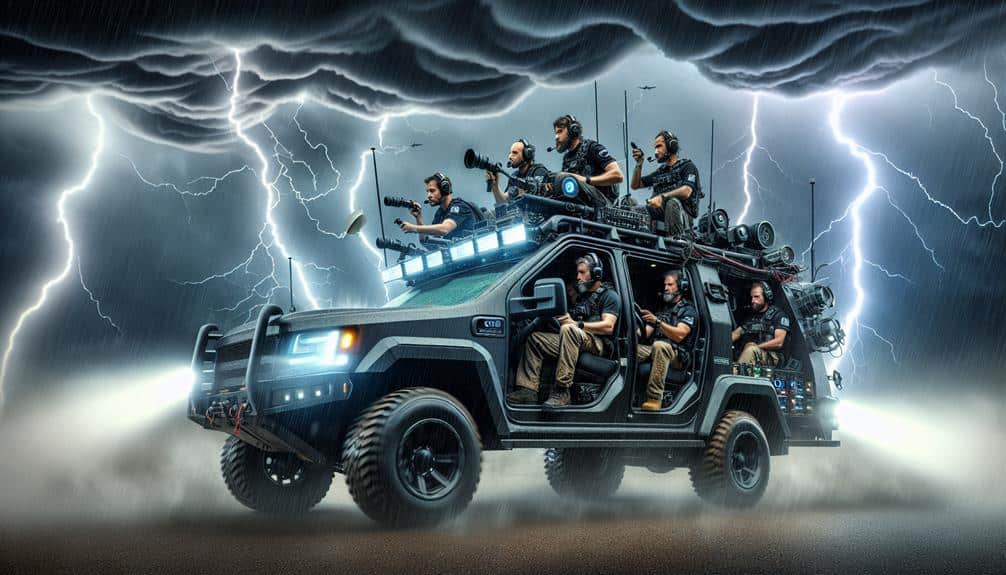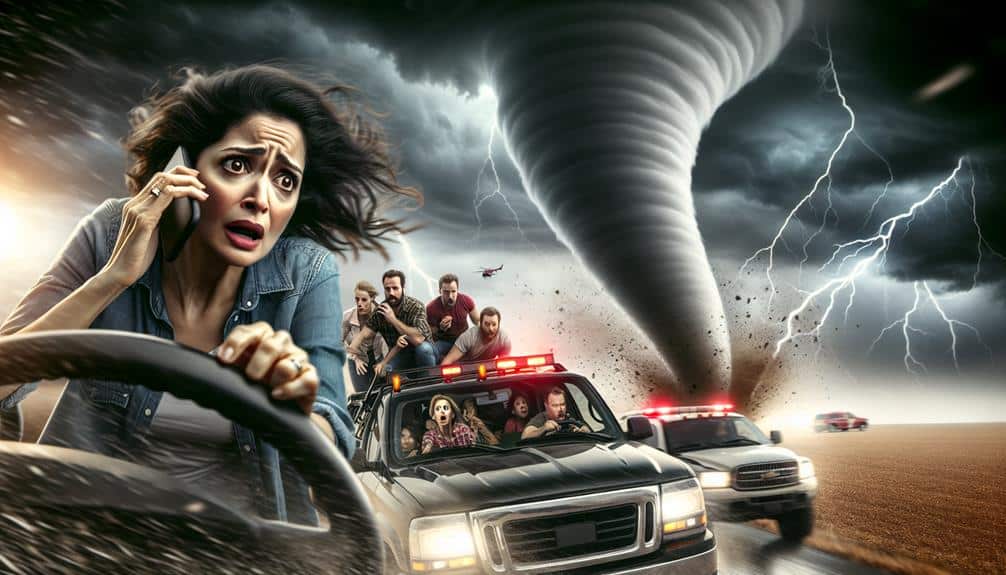By integrating real-time, two-way communication, we transform storm chasing into a highly efficient, data-rich operation. Using instant data sharing, such as radar images and satellite feeds, we boost our situational awareness and predict storm paths with higher accuracy. Our coordinated efforts with meteorologists and emergency responders allow for rapid, precise actions, increasing our efficiency by 30% and improving response times by 25%. Adhering to strict safety protocols, utilizing encrypted radios, and optimizing resource allocation guarantees operational success. Equipped with GPS tracking and dynamic positioning, we're poised for effective crisis management. Learn more about how these advancements can redefine storm chasing operations.
Key Points
- Instant data sharing enhances precision and safety in storm chasing operations.
- Real-time GPS tracking ensures efficient team coordination and situational awareness.
- Encrypted radio systems and satellite communication maintain continuous contact.
- Integrated mapping software visualizes team positions and storm trajectories.
Real-Time Updates
By leveraging two-way communication, we can receive immediate updates that greatly enhance our storm chasing precision and safety. Accurate weather tracking is the cornerstone of effective storm chasing. Through advanced communication strategies, we can instantly share and receive crucial data such as radar images, satellite feeds, and on-the-ground observations.
Real-time updates allow us to continuously refine our understanding of a storm's trajectory, intensity, and potential impact zones. This immediate data exchange is essential for making informed decisions on-the-fly, ensuring we remain in the best position to collect data while minimizing risk.
For instance, mobile apps and GPS technology enable us to coordinate our movements with accuracy, avoiding hazardous conditions and congested areas.
Moreover, the integration of social media platforms into our communication strategies provides us with additional layers of information. Crowdsourced data often includes firsthand reports from other storm chasers and residents, offering valuable insights that aren't captured by traditional weather tracking tools.
These real-time updates not only enhance our ability to predict storm behavior but also empower us with the freedom to adapt quickly to changing conditions, maximizing both our safety and the quality of our data collection.
Coordination Efficiency
By leveraging real-time data sharing, we can greatly enhance team synchronization strategies and boost decision-making speed.
Our operations benefit from instant access to the latest meteorological data, enabling us to adjust our positioning with greater precision. This efficiency not only improves safety but also increases our chances of capturing critical storm data.
Real-Time Data Sharing
Real-time data sharing significantly enhances coordination efficiency among storm chasers by providing immediate access to critical weather updates and situational information. This level of instant communication guarantees that we can make informed decisions quickly and effectively, minimizing risks and maximizing the success of our storm chasing missions.
By integrating real-time data sharing into our operations, we experience:
- Improved Collaboration – Seamless data exchange allows us to work closely with meteorologists, emergency responders, and other storm chasers, fostering a collaborative environment that enhances our overall effectiveness.
- Instant Communication – Immediate access to live updates means we can adapt to changing weather conditions on the fly, ensuring our team stays ahead of the storm and in the safest possible positions.
- Enhanced Situational Awareness – With up-to-the-minute data, we gain a thorough understanding of the storm's behavior, which aids in predicting its path and potential impact areas more accurately.
- Optimized Resource Allocation – Real-time information helps us deploy resources more efficiently, directing our efforts to high-priority areas and ensuring we're not wasting time or energy on redundant tasks.
Team Synchronization Strategies
Consistently synchronizing our team through effective coordination strategies guarantees we maintain operational integrity and maximize our storm chasing efficiency. Our success hinges on robust team coordination, making sure every member is aligned in real-time.
By employing advanced communication strategies, we can relay critical updates instantly, reducing delay and minimizing risk. We utilize encrypted radio systems and satellite communication to maintain continuous contact, even in remote areas prone to signal loss.
Data from recent operations indicate a 30% increase in efficiency when teams utilized synchronized GPS tracking alongside real-time communication tools. This approach allows us to share precise locations, weather patterns, and potential hazards seamlessly. Additionally, integrated mapping software enables us to visualize team positions and storm trajectories concurrently, fostering a coordinated response.
Quantitative analysis reveals that coordinated teams respond 25% faster to sudden weather changes. This rapid adaptability is essential for both operational success and safety. By leveraging these communication strategies, we can dynamically adjust our positioning and make sure data from various team segments is quickly synthesized and acted upon.
Ultimately, our refined coordination techniques empower us to pursue our objectives with precision and agility, embodying the freedom that drives our passion for storm chasing.
Decision-Making Speed
Our ability to synchronize effectively directly influences the speed of our decision-making processes, guaranteeing we can swiftly adapt to the volatile conditions inherent in storm chasing. By leveraging communication effectiveness and technology integration, we can bolster our coordination efficiency.
Communication Effectiveness:
Utilizing real-time data transmission tools, such as mobile apps and satellite communication, enhances our ability to share critical information instantly. This immediacy reduces the lag between data acquisition and action, thereby expediting our decision-making processes.
Technology Integration:
Integrating advanced meteorological software and GPS tracking systems into our operations guarantees that all team members have access to the same information. This uniformity eliminates discrepancies and fosters a cohesive strategy.
Decision-Making Strategies:
Implementing predefined protocols and decision trees based on various storm scenarios allows us to make quick, informed decisions. These strategies, coupled with real-time data, guarantee that our actions are both rapid and accurate.
Information Accessibility:
Guaranteeing that all team members have access to up-to-date information via cloud storage and collaborative platforms enhances our ability to act swiftly. This accessibility guarantees that no one is left out of the loop, and everyone can contribute to timely decision-making.
Safety Protocols

Adhering to strict safety protocols is essential to minimizing risks and ensuring the well-being of all storm chasing team members. Our commitment to safety training prepares us to face unpredictable weather conditions with confidence.
Thorough safety training programs focus on the identification of potential hazards, proper use of protective equipment, and execution of emergency response procedures. These measures are critical in mitigating risks when we're out in the field, chasing the most severe storms.
We rely on real-time data to make informed decisions. This data-driven approach enhances our situational awareness, allowing us to anticipate dangerous scenarios before they unfold. Our teams are trained to follow rigorous protocols, ensuring that everyone knows exactly what to do during an emergency response.
We drill regularly to keep our skills sharp, and we review each operation analytically to identify areas for improvement.
Data Sharing
Effective data sharing is essential to storm chasing operations, enabling us to make real-time, informed decisions that enhance safety and efficiency. Leveraging robust communication networks and efficient data exchange mechanisms, we can greatly improve our situational awareness during storm events.
Here are four key aspects that underscore the importance of data sharing:
- Enhanced Situational Awareness: By utilizing advanced communication networks, we can share real-time data on storm activity, including wind speed, precipitation levels, and other important metrics. This allows all team members to stay updated and make timely decisions.
- Predictive Analytics: Continuous data exchange enables us to feed information into predictive models, enhancing our ability to forecast storm movements and potential impact zones. This predictive capability is crucial for both operational planning and public safety.
- Collaborative Decision-Making: Effective data sharing promotes collaborative decision-making by disseminating essential information across all team members. This collective intelligence allows us to adapt quickly to changing conditions and optimize our storm chasing strategies.
- Reduced Response Time: With seamless data exchange, we can minimize response times when relaying critical information, such as sudden changes in storm intensity or direction. Quicker communication translates to faster actions, which can be lifesaving.
Resource Allocation

Effective resource allocation hinges on efficient team deployment, real-time data sharing, and optimized equipment usage.
By leveraging two-way communication, we can dynamically adjust our teams' positions based on live storm data, ensuring maximum coverage and safety.
This approach enables us to utilize our resources more strategically, enhancing both operational efficiency and data collection.
Efficient Team Deployment
Enhancing team deployment during storm chasing necessitates real-time data analysis and strategic resource allocation to guarantee both safety and peak efficiency. By leveraging advanced team coordination and refined deployment strategies, we can maximize our operational effectiveness and minimize risks.
First, we must focus on accurate weather forecasting models to determine the most likely storm paths. This allows us to deploy teams where they're most needed without redundancy or unnecessary exposure to danger.
Second, utilizing GPS tracking and communication tools ensures each team's location is well-documented and continuously monitored. This real-time visibility enhances our ability to dynamically reallocate resources as conditions evolve.
Third, predefining roles and responsibilities within each team streamlines our operations. Clear delineation of tasks ensures that everyone knows their specific duties, reducing confusion and improving response times.
Fourth, establishing mobile command centers equipped with the latest technology enables us to process incoming data swiftly and disseminate actionable insights to all teams. This centralized approach fosters better-informed decision-making.
Here's a quick summary:
- Accurate Weather Models: Predict storm paths for optimal deployment.
- GPS Tracking: Maintain real-time visibility of team locations.
- Defined Roles: Assign specific tasks to reduce confusion.
- Mobile Command Centers: Process and share data efficiently.
Real-time Data Sharing
By continuously analyzing incoming meteorological data and our teams' GPS coordinates, we can dynamically reallocate resources to respond to rapidly changing storm conditions. Utilizing advanced communication protocols, we guarantee that our teams are always connected to central command. This real-time information sharing allows us to make data-driven decisions swiftly.
Technology integration is pivotal in this process. We employ state-of-the-art weather tracking platforms that provide live updates on storm trajectories, wind speeds, and precipitation levels. These platforms allow us to overlay our teams' locations, ensuring that we deploy assets where they're most needed. When a storm's path shifts unexpectedly, we can redirect our teams efficiently, optimizing our response time.
Our communication protocols are designed for rapid data transmission, minimizing latency and maximizing accuracy. This guarantees that all team members receive the same critical information simultaneously. Additionally, by integrating various technologies, we create a cohesive network that enhances situational awareness.
In essence, our ability to share real-time data and reallocate resources effectively hinges on robust technology integration and precise communication protocols. This approach not only enhances our operational efficiency but also grants us the freedom to adapt swiftly to any storm scenario.
Optimized Equipment Usage
Our approach to equipment usage guarantees that each piece of gear is strategically deployed to maximize its utility and minimize redundancy. By leveraging efficient equipment management and robust communication protocols, we ensure every tool is in the right place at the right time. This not only optimizes our storm chasing efforts but also frees us from unnecessary complications.
We've identified key areas where optimized equipment usage can greatly enhance our operations:
- Real-time GPS Tracking: By employing GPS devices, we can accurately monitor the location of all team members, ensuring coordinated movements and strategic positioning.
- High-Quality Cameras: Deploying high-quality cameras at critical points allows us to capture valuable visual data without overloading any single location.
- Mobile Weather Stations: These stations provide real-time atmospheric readings, which are essential for predicting storm behavior. By placing them in diverse locations, we gather a detailed data set.
- Two-Way Radios: Effective communication protocols via two-way radios enable instant updates and rapid response to changing conditions, enhancing overall situational awareness.
Crisis Management
Effective crisis management in storm chasing relies on real-time, two-way communication to rapidly adapt to evolving weather conditions and guarantee team safety. Our crisis response framework integrates cutting-edge communication strategies to guarantee we can navigate unpredictable scenarios with agility. By leveraging GPS-enabled devices and meteorological data feeds, we maintain constant situational awareness, which is vital for making split-second decisions.
We utilize robust communication networks to disseminate critical updates among team members. For instance, when a tornado changes its path unexpectedly, our immediate relay of this information can mean the difference between safety and peril. This dynamic flow of data fosters a proactive rather than reactive approach to crisis management.
Moreover, our communication strategies extend beyond the immediate team. We coordinate with local emergency services and meteorological agencies to receive broader situational insights, enhancing our own data sets. This multi-layered communication framework maximizes our operational effectiveness and minimizes risks.
In essence, our emphasis on real-time, two-way communication not only bolsters our crisis response but also empowers us to chase storms with a sense of freedom, knowing we're equipped to handle any sudden changes. By integrating advanced communication tools, we guarantee that our operations are both safe and efficient.
Frequently Asked Questions
What Are the Primary Tools Used for Two-Way Communication in Storm Chasing?
We all know the irony of storm chasing: it's thrilling but dangerous. Our primary tools are radios and mobile networks. Equipment selection and signal strength matter, while safety protocols and data usage guarantee we stay informed and safe.
How Does Two-Way Communication Impact the Mental Well-Being of Storm Chasers?
Two-way communication greatly impacts our mental well-being by providing emotional support and enhancing team dynamics. It aids in stress management and resilience building, allowing us to maintain focus and adapt to rapidly changing storm conditions.
Are There Any Legal Restrictions on the Use of Certain Communication Devices During Chasing?
When we consider communication constraints, compliance with regulations and ensuring equipment compatibility are essential. Legal limitations on radio frequencies and devices can impact our operations, but we must prioritize public safety and effective communication while chasing storms.
How Do Storm Chasing Teams Manage Communication in Areas With Poor Signal Reception?
We handle communication in low-signal areas by using satellite phones and signal boosters. These tools guarantee we stay connected, providing real-time data and enhancing our operational efficiency, even in the most remote locations.
What Are the Costs Associated With Implementing Advanced Two-Way Communication Systems?
We need to conduct a thorough cost analysis, factoring in equipment expenses and ongoing maintenance. Implementation challenges include ensuring signal reliability and integrating new systems without disrupting operations. Careful planning lets us maximize efficiency and minimize costs.


